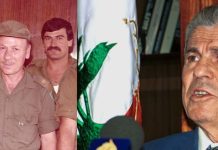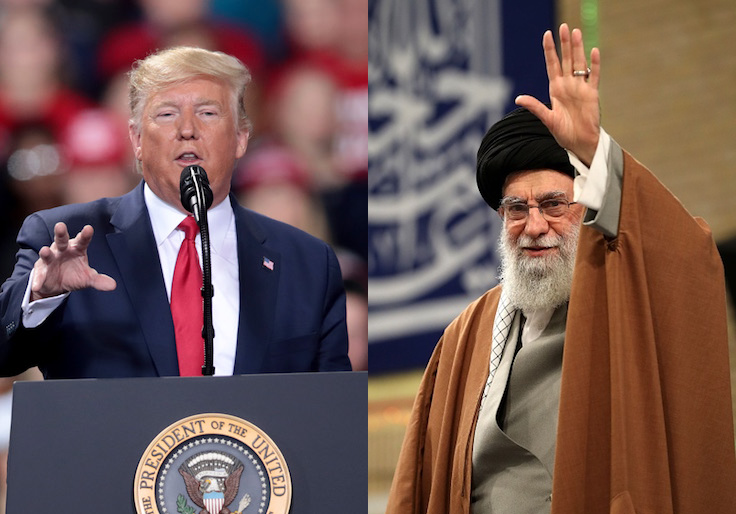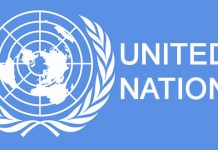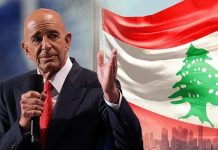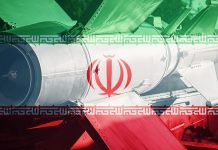ثمانية تقارير وتعليقات باللغة الإنكليزية تتناول إجرام ومخططات توسع وحروب وإرهاب والممارسات البربرية لنظام ملالي إيران الدكتاتوري إضافة إلى الجهود الدولية لردع واحتواء وتدجين الملالي العطشى للدماء
Eight Reports & Editorials Addressing The Iranian Theocratic regime’s Criminal Acts, Terrorism, Expansion schemes, wars, plots and anti human conduct, in addition to world-wise efforts to tame, contained and deterred the Blood Hungry Mullahs.
*Iran’s Khamenei faces new struggles as he celebrates 81st birthday/Jason M.BrodskyLjerusalem Post/April 28/2020
*Iran: Mullahs Using Coronavirus to Heighten Anti-Americanism/Majid Rafizadeh//Gatestone Institute/April 28/2020
*COVID-19 and (IAEA) the International Atomic Energy Agency: Where does the Iran mission stand?/Andrea Stricker/Jacob Nagel/FDD/April 28/2020
*Iranian-backed militias playing key role in Anbar against ISIS/Seith J.Frantzman/Jerusalem Post/April 27/2020
*Iran’s gamble of military provocations for concessions is not working on Trump/Michael Pregent/Al Arabiya/April 26/2020
*US-Iran war unlikely amid coronavirus – but nuclear program always a risk/Ryan Bohl/Al ArabiyaApril 26/2020
*Lifting Iran arms embargo would increase regional disorder/Dr. Mohammed Al-Sulami/Arab News/April 27/2020
*Iranian general emerges as central figure as tensions with US rise over amid ballistic programme/Thomas Seibert/The Arab Weekly/April 27/2020
*******************
Iran’s Khamenei faces new struggles as he celebrates 81st birthday
Jason M.BrodskyLjerusalem Post/April 28/2020
Amid Iran’s satellite launch, harassment of US warships, and attacks on coalition troops, a recent development has gone underreported: Iran’s Supreme Leader Ayatollah Ali Khamenei turned 81 on April 19.
Although official documents in Iran list his birthday as being in July, the supreme leader’s website recognizes April 19 as the real date. The octogenarian is one of the longest-serving leaders in the Middle East. His power, presence and position extend well beyond the borders of the Islamic Republic.Khamenei’s 80th year was an annus horribilis by any measure: protests over gas policies led to as many as 1,500 deaths; a US drone strike took out his top mastermind Qasem Soleimani; there was a record-low turnout in Iran’s parliamentary elections; and the coronavirus pandemic has shaken Iranian society.
But the supreme leader has persisted, with a recent propaganda poster from his office carrying the slogan “Hurting but dignified.” Early indications reveal that this year will be one of consolidation at home and adaptation abroad.
Domestic control
Domestically, the results of the last parliamentary election offer a guide to Khamenei’s thinking. More than 7,000 candidates were disqualified from running out of more than 15,000 hopefuls, including some 90 sitting members of parliament. In contrast to the last legislative elections of 2016, when President Hassan Rouhani’s allies won all 30 seats from Tehran and 41% of the overall seats, the results from the 2020 election were a setback to Rouhani’s brand of politics, with hardliners winning 221 out of 290 seats, an increase of 83 seats. The personalities behind the winning coalition reveal Khamenei’s hidden hand, with three close associates playing leading roles in the election. The triumphant coalition – named the Council of Islamic Revolution Forces Alliance – was chaired by Gholam-Ali Haddad Adel. Haddad Adel isn’t just a former speaker of parliament but is more importantly an in-law of the supreme leader. While Haddad Adel himself wasn’t a candidate, additional Khamenei confidants found themselves in the top slots.
IDF intelligence’s constant eye on coronavirus and Iran
Mohammad Bagher Qalibaf, who won the most votes in February as a former mayor of Tehran and commander of the Islamic Revolutionary Guard Corps (IRGC) Air Force, is a contender to become the next speaker. There is evidence to suggest that at one point he had a political partnership with the supreme leader’s influential son, Mojtaba Khamenei. A leaked 2008 US State Department cable once included an account which described him as the “’backbone’ of Qalibaf’s past and continuing election campaigns.” Although Qalibaf has demonstrated some independence during his career, and while there is speculation the supreme leader’s son once counseled his father to switch his support to Mahmoud Ahmadinejad in the 2005 election, he remains a trusted member of Khamenei’s larger patronage network, with the supreme leader finding a seat for him on the Expediency Council after his service as mayor of Tehran. After Qalibaf, Mostafa Mir-Salim won the second-most votes in Tehran. Like Qalibaf, Mir-Salim is a Khamenei appointee to the Expediency Council. Mir-Salim also served as a senior aide to the supreme leader during his presidency. This stands in contrast to the winning slate of the 2016 elections, with the less reliable former Reformist vice president Mohammad Reza Aref, who once demanded the release of the leaders of the Green Movement who remain under house arrest, receiving the most votes from the List of Hope. Ali Motahari, who has questioned the supreme leader’s authority, also won a seat in the 10th parliament. But Motahari has become so controversial to the Islamic Republic’s establishment, he wasn’t even allowed to run in the 2020 election. Thus, trusted Khamenei associates have been engineering and pioneering the new parliament.
IN ADDITION to this consolidation of personalities, Khamenei and the Islamic republic’s deep state have slowly chipped away at parliament’s already limited authority over the past year. The creation of the Supreme Economic Coordination Council (ECC) in 2018, which greenlighted the Islamic Republic’s new gas policy in November, raised hackles from members of parliament, criticizing the body’s usurpation of legislative prerogatives. Khamenei reportedly went as far as to send a note to the legislative chamber, warning its members not to oppose the gas policy. There were similar complaints over the Expediency Council’s dithering over legislation passed by parliament to satisfy the Financial Action Task Force’s action plan for Iran. That’s not to mention that in March, the supreme leader approved the use of Article 85 of the constitution for this year’s budget, which bypassed consideration by a full session of parliament due to the coronavirus. These developments are evidence that Khamenei is consolidating the personalities and processes of the Islamic republic to affect his succession as he ages. The new parliament will be in office until 2024, when the supreme leader would turn 85. The presence of loyal aides-de-camp, the sidelining of troublemakers, and the centralization of authority are all part of this process.
Regional Adaptation
The death of Qasem Soleimani left a void in implementation of Iran’s regional strategy. There are indications that since January, the regime has struggled to recreate a durable oversight mechanism for its proxies and partners, given Soleimani’s singular imprimatur over Iran’s Axis of Resistance after two decades as commander of the Quds Force. This has manifested itself in a fragmentation of control, with four players emerging to fill the leadership vacuum: Secretary of Iran’s Supreme National Security Council Ali Shamkhani; Lebanese Hezbollah’s representative in Iraq Mohammad Kawtharani; the new head of the Quds Force Esmail Ghaani; and his deputy Mohammad Hejazi.
Soleimani’s fluency in Arabic increased his ability to manage and meddle throughout the region. This stands in contrast to his replacement, Esmail Ghaani, who doesn’t share his command of the language. In addition to a language barrier, Ghaani doesn’t command the same charisma as Soleimani in Iran’s western theater, with his experience resting in Quds Force operations to the east, particularly Afghanistan. That’s not to mention Ghaani spending much of his career as a deputy commander, in contrast with the Islamic Republic’s deep bench of experienced officers who have helmed multiple armed organs, like Ali Shamkhani as a former head of the IRGC Navy and the regular navy, and Hejazi, as a former commander of the Basij armed force and a one-time deputy commander-in-chief of the IRGC. This is all in addition to Shamkhani being an ethnic Arab himself, Hejazi’s recent experience coordinating Quds Force operations in Lebanon, and Kawtharani taking over “some of the political coordination of Iran-aligned paramilitary groups” after Soleimani’s death, according to the US State Department. These experiences position these three men to compensate for Ghaani’s linguistic and geographic weaknesses.
The concerns over Ghaani’s ability to serve as an effective replacement surfaced as he traveled to Syria and Iraq in recent weeks – his first public trips since ascending to the top job – following a similar trip to Baghdad by Shamkhani. Arab media reports suggested Ghaani struggled to unify the rank and file of Iran’s Shi’ite allies in Iraq, and that Muqtada al-Sadr reportedly nixed a previously scheduled meeting with him. While Iran still succeeded in the torpedoing of Adnan al-Zurfi’s nomination for prime minister of Iraq and the ushering in of a more acceptable replacement, Mustafa al-Kadhimi, fissures among Iran-backed Popular Mobilization Forces (PMF) remain. Kata’ib Hezbollah described al-Kadhimi’s nomination as prime minister as a “declaration of war against the Iraqi people,” dubbing him a “suspicious figure,” despite support from other Iran-backed Shi’ite elements.
Likewise, Kata’ib Hezbollah didn’t appear to sign on to a joint statement among other PMFs this month saying US forces would be dealt with as occupiers. This complicated landscape suggests over the next year that Iran’s supreme leader will be relying on multiple actors with mixed results, until the regime establishes a durable oversight structure for its Axis of Resistance. As Iran’s supreme leader celebrates a new year, he’s grappling with multiple crises: over legitimacy, leadership and legacy. Over the coming months, we will continue to witness fortification at home and improvisation abroad.
The writer is the policy director of United Against Nuclear Iran (UANI). He is on Twitter @JasonMBrod
Iran: Mullahs Using Coronavirus to Heighten Anti-Americanism
Majid Rafizadeh//Gatestone Institute/April 28/2020
Iran’s covert disinformation operations concerning COVID-19 are not only aimed at inciting hatred toward the US; they are also, it seems, aimed at negatively impacting the international community’s efforts to fight the virus.
Whenever social media accounts or websites linked to the Iranian regime’s disinformation campaigns are exposed and removed, the Islamic Republic seems to find other outlets or else creates new accounts to continue spreading its propaganda.
Even amid the coronavirus outbreak and public health crisis, the Iranian regime seems to still prioritize its revolutionary ideals and its anti-American agenda. Unfortunately, the United Nations and the EU remain silent on the Iranian regime’s efforts to spread disinformation as well as on its other malign behavior.
While the US has offered medical assistance to Iran, the regime in Tehran appears to be exploiting the coronavirus pandemic to spread disinformation. It includes pro-China and anti-US narratives, most likely to ratchet up anti-Americanism.
Recently, the social media analyst Graphika revealed that a pro-Iranian influencing operation, known as the International Union of Virtual Media (IUVM), had begun a social media disinformation campaign about the coronavirus outbreak around end of February.
According to the detailed report:
“the ‘International Union of Virtual Media’ – is a prolific operator that is centered on websites rather than social media. Its long-running practice has been to create or copy web-based content that amplifies Iranian government narratives, then post it to social media accounts that pose as independent news outlets or journalists.”The disinformation campaign is centered on spreading the narrative that the US government developed the novel virus in order to advance its interests around the globe. The IUVM argued, through its posts on social media, that “it is no coincidence that the virus selectively goes to countries that are considered enemies of the United States, namely China, Iran, some EU countries, including Italy”, based on Graphika’s report.
“Much of the [Facebook] account’s content attacked Trump, in line with Iranian state narratives” the report added.
“It is pro-Iran and pro-Palestinian, while taking every opportunity to criticize Saudi Arabia, the United States, Israel and the Saudi-led war in Yemen… IUVM copies its content verbatim from Iranian regime sources such as PressTV and the website of Ayatollah Khamenei, but posts it without attribution.”
The disinformation network, using sophisticated methods, includes in its contents “video reports, news articles and memes that it hosts on a series of IUVM-branded websites, and then posts across social media accounts that the operation controls more or less covertly.”
“Over the past few years, social media platforms such as Facebook, Google and Twitter have repeatedly removed IUVM accounts from their platforms for being engaged in pro-Iran information operations and deceiving users, and have continued investigating and disrupting this network.”
Iran’s covert disinformation operations concerning COVID-19 are not only aimed at inciting hatred toward the US; they are also, it seems, aimed at negatively impacting the international community’s efforts to fight the virus. As the US Deputy Assistant Secretary of Defense for Russia, Ukraine and Eurasia, Laura Cooper, pointed out in an April 13 statement:
“These are messages that are endangering global health because they’re undermining the efforts of governments, of health agencies and of organizations that are in charge of disseminating accurate information about the virus to the public.”
This was not the first time the Iranian regime’s disinformation operations have been exposed. In August 2018, for example, a cybersecurity firm, FireEye, also revealed data about Iran’s widespread misinformation campaigns. Of course, Iran has been spreading disinformation about its nuclear and missile development programs for decades.
After the report, some of the giant social media platforms took action and removed hundreds of accounts said to be linked to the Iranian government. Facebook, for example, had to remove “652 pages, groups and accounts for coordinated inauthentic behavior that originated in Iran and targeted people across multiple internet services.” Other popular social media outlets, such as Twitter and Google owner Alphabet, have also identified and removed many “inauthentic” accounts that evidently originated in Iran.
Those accounts, not surprisingly, were also busy promoting the Iranian regime’s narratives and interests. As Facebook explained on August 21, 2018:
“Based on FireEye’s tip, we started an investigation into ‘Liberty Front Press’ and identified additional accounts and Pages from their network. We are able to link this network to Iranian state media through publicly available website registration information, as well as the use of related IP addresses and Facebook Pages sharing the same admins. For example, one part of the network, ‘Quest 4 Truth,’ claims to be an independent Iranian media organization, but is in fact linked to Press TV, an English-language news network affiliated with Iranian state media.”
Also not surprisingly, whenever social media accounts or websites linked to the Iranian regime’s disinformation campaigns are exposed and removed, the Islamic Republic seems to find other outlets or else creates new accounts to continue spreading its propaganda.
Even amid the coronavirus outbreak and public health crisis, the Iranian regime seems to still prioritize its revolutionary ideals and its anti-American agenda. Unfortunately, the United Nations and the EU remain silent on the Iranian regime’s efforts to spread disinformation as well as on its other malign behavior. Just this week, it was reported that Iran executed “at least six… people in recent days…. According to the latest annual Amnesty International report released last Tuesday, about one-third of executions worldwide are carried out in Iran.”
*Dr. Majid Rafizadeh is a business strategist and advisor, Harvard-educated scholar, political scientist, board member of Harvard International Review, and president of the International American Council on the Middle East. He has authored several books on Islam and US foreign policy. He can be reached at Dr.Rafizadeh@Post.Harvard.Edu
© 2020 Gatestone Institute. All rights reserved. The articles printed here do not necessarily reflect the views of the Editors or of Gatestone Institute. No part of the Gatestone website or any of its contents may be reproduced, copied or modified, without the prior written consent of Gatestone Institute.
COVID-19 and (IAEA) the International Atomic Energy Agency: Where does the Iran mission stand?
Andrea Stricker/Jacob Nagel/FDD/April 28/2020
If Iran continues to stonewall, the IAEA should vote to refer the matter to the UN Security Council for the re-imposition of sanctions lifted under the nuclear deal.
At the height of the COVID-19 outbreak in the Islamic Republic of Iran, the International Atomic Energy Agency (IAEA) fell into a worrying slowdown of inspections. Now it is rebounding. IAEA officials say close to full teams of inspectors are flying back and forth from Tehran.
IAEA Director General Rafael M. Grossi announced that for the first time in the UN nuclear watchdog’s history, it is using chartered jet flights to conduct safeguards visits. One senior IAEA official remarked to his team that he is very pleased with the solution, stating from now on, “The sky is our limit.”
These welcome developments come at a time when the IAEA is closely monitoring Iran’s consistent reduction of its commitments to the 2015 nuclear deal, or Joint Comprehensive Plan of Action (JCPOA). The IAEA reported last month that Tehran now has adequate low-enriched uranium for more than one nuclear weapon, and is steadily deploying advanced centrifuges to allow it to enrich uranium at a quicker pace.
Simultaneously, the IAEA is undertaking an investigation into Iran’s alleged violations of its obligations under the Nuclear Non-Proliferation Treaty (NPT), including denial of access to two sites and refusal to answer questions about another matter. Information from Israeli intelligence led the IAEA in April 2019 to also detect undeclared, refined uranium particles at a site in the Tehran neighborhood of Turquz-Abad. Iranian officials have yet to explain.
Whether the IAEA is able to continue its important work, including obtaining immediate and unrestricted physical access to nuclear sites, will have serious ramifications for safeguarding Tehran’s nuclear activities and clearing up past and possibly ongoing safeguards infractions. The agency will need to guard against any attempts by Iran to avoid tough questions or exploit the health crisis for proliferation purposes.
The IAEA’s efforts in Iran currently fall along two separate tracks. It is carrying out an investigation into alleged undeclared nuclear material and activities, while also applying routine safeguards at the Islamic Republic’s nuclear facilities. According to the most recent data in the IAEA’s Safeguards Implementation Report for 2018, out of 421 total inspections the agency carried out that year in 59 countries, 385 took place at Iran’s 21 nuclear facilities. This was in addition to conducting “complementary access” visits to other sites of interest to the IAEA, pursuant to Iran’s Additional Protocol. The agency’s task of safeguarding Iran’s nuclear program is thus significant – and a mission compounded in difficulty by a pandemic.
Over the past two years, the IAEA obtained startling new information from the government of Israel about potentially undeclared nuclear material and activities in Iran. In January 2018, the Mossad seized a vast archive of Iran’s nuclear files from locked vaults at a Tehran warehouse.
The archive’s contents detailed a vast, pre-2003 Iranian program aimed at developing one or two nuclear weapons per year. The information directed the IAEA to new sites, personnel and activities of interest. Even though many of the activities described occurred long before the negotiation of the JCPOA, some may continue, according to Iranian memoranda among the documents. The archive’s information has been corroborated by other governments and non-governmental experts.
Iran has not reacted well to the discovery, denying the authenticity of the materials. In recent months, however, senior IAEA officials have been meeting with Iranian officials to raise difficult technical questions about those matters, some of which were covered in the March IAEA NPT safeguards report. This includes Iran’s denial of access to the two suspicious sites and its refusal to answer direct questions about those sites and another matter.
So far, IAEA officials privately report, the agency is determined to continue pressuring Iran to approve unrestricted access to the sites. Director General Grossi is also planning a visit toward the end of April to make sure the IAEA’s requests are progressing in the right direction.
To counter the IAEA’s demands, Iran has stated its desire to negotiate a “roadmap” toward eventually discussing the agency’s requests to visit the two sites and related topics. Seeing this as a stalling tactic, according to the IAEA officials, the agency told Iran that it is only willing to discuss specific technical and logistical matters connected directly to the visit parameters and continues to demand immediate, unrestricted access.
Tehran has used similar stalling tactics in the past, which typically have two main goals. The first is to buy time to allow officials to “organize” the suspect sites – actually sanitization efforts entailing cleaning, moving away of materials and machines, and scraping or covering earth to defeat IAEA environmental sampling. Iran has undertaken such efforts at multiple other sites in the past, and most recently at the Turquz-Abad warehouse where the IAEA found uranium.
Iran’s other goal is to indicate that cooperation with agency investigations is forthcoming, hoping that meanwhile, pressure from the IAEA Board of Governors would diminish. Such tactics are frequently successful with the Russians and Chinese.
Notably, the IAEA’s NPT compliance investigation in Iran is a renewed one, restarted following the installation of a new director general last December. The JCPOA mistakenly closed an earlier investigation into the military dimensions of Iran’s nuclear activities. It is on this basis that Iran now denies that it must answer any of the IAEA’s questions about its past.
After the March COVID-19 slowdown began, the agency is reportedly back in action in Iran to routinely apply safeguards. It appears to have returned to a near-normal pace of conducting physical inspections in the Islamic Republic after overcoming several obstacles.
Last month, inspectors’ travel plans to Iran were abruptly canceled and several officials were temporarily quarantined in Tehran hotels. The IAEA even contemplated installing additional remote monitoring measures at Iran’s nuclear sites as a substitute for actual inspections. Since March 16, the IAEA’s offices in Vienna have been shuttered and its officials working from home.
The IAEA’s Grossi explained in a video statement that the coronavirus outbreak “is putting an enormous challenge in front of everybody. The IAEA is no exception.”
Grossi stated, however, that “IAEA operations are expected to continue with minimal disruption under these extraordinary circumstances. Safeguarding nuclear materials all over the world will not stop for a single minute,” he elaborated. In a separate statement to The Jerusalem Post, an IAEA spokesperson reiterated, similarly, that the agency is not stopping its Iran work “for a single minute.”
According to an IAEA official, a team flew to Iran on April 17, and another team will arrive at the end of the month. During its last visit, the IAEA also transferred to Tehran two coronavirus testing machines. Inspectors also visited the Bushehr Nuclear Power Plant. While air transportation and physical visits to certain sites in areas of greater COVID-19 outbreaks have been more limited, the IAEA intends to visit all necessary sites.
In order to encourage the inspectors to continue their work during the outbreak, the director general decided to allow hazard pay. Every inspector will be entitled to a special bonus, a “critical mission travel allowance,” worth up to $1,600 per month and based on actual days in the field.
IAEA officials also stated that remote and electronic monitoring remains in place at Iran’s two declared enrichment sites, Natanz and Fordow, and it continues to conduct physical inspections. The IAEA is tracking uranium production and accumulation at those facilities, as well as Iran’s ongoing centrifuge research and development. Installation and operation of additional advanced centrifuges, and Iran’s accumulation of vast amounts of low enriched uranium, continue in violation of the nuclear accord. Thus, the agency is able to track the extent to which Iran is continuously surpassing the limits. The IAEA reported its latest data on Iran’s JCPOA non-compliance in a separate safeguards report.
During the COVID-19 outbreak, the IAEA should continue to pressure Iran to cooperate with its investigation and allow immediate and unrestricted visits to suspicious sites. Despite the IAEA’s safeguards, Iran continues to expand its enrichment program to threatening levels. As noted above, it now has adequate low-enriched uranium for more than one nuclear weapon and continues to install faster centrifuges.
The agency should take pandemic-related precautions for its inspectors but maintain regular physical inspections at all Iranian nuclear sites. Tehran is likely to exploit any reduction in monitoring and could use the pandemic as an excuse to deny or delay access. Were it to manufacture an access crisis on the pretense of a COVID-19-related issue, Tehran could divert uranium and continue enriching it at clandestine facilities, using newer, easier-to-hide advanced centrifuge capabilities.
Remote monitoring mechanisms already employed by the IAEA are important, but only to enhance its mission. The IAEA should not rely heavily on these in the mistaken assumption that they can replace information obtained via physical visits. Nor should the agency be drawn into lengthy discussions about a roadmap for access, which will ultimately serve no purpose.
The IAEA’s board of governors should support the agency’s investigation and vote on a resolution to condemn any Iranian failure to cooperate. If it continues to stonewall, the board should vote to refer the matter to the UN Security Council for the re-imposition of sanctions lifted under the nuclear deal. Only international unity in the face of Tehran’s ongoing obstruction will yield results.
*Andrea Stricker is a research fellow focusing on nonproliferation at the Foundation for Defense of Democracies (FDD), where Brig.-Gen. (res.) Jacob Nagel is a senior fellow and also a visiting professor at the Technion Aerospace Engineering Faculty. He previously served as Prime Minister Benjamin Netanyahu’s acting National Security Advisor and head of the National Security Council.
Iranian-backed militias playing key role in Anbar against ISIS
Seith J.Frantzman/Jerusalem Post/April 27/2020
US-Iran tensions and protests in Iraq, as well as other issues that lead to instability have enabled ISIS cells to continue to function.
The Popular Mobilization Units (PMU), a paramilitary group of the Iraqi security forces which also tend to be pro-Iranian, have continued to play a central role in operations on Iraq’s borders, according to Iranian media. An operation to clear ISIS cells from Anbar province on the Syrian border was conducted over the weekend. It is the second of similar operations this month to clear border areas.
In the current operation, according to Tasnim News, the PMU had sent its Anbar operations command on pre-emptive raids to strike ISIS cells. The PMU was also continuing operations to find mines and improvised explosive devices. ISIS has continued to operate in Iraq more than two years after it was mostly defeated. With the coronavirus pandemic and drawdown of US-led Coalition forces there are concerns ISIS could increase its foothold. In addition US-Iran tensions have led to US airstrikes on the PMU after units within the PMU fired rockets at bases where US troops were located.
Another article on April 10 noted that the PMU was continuing to “clear the Iraqi border with Jordan and Saudi Arabia.” These two articles illustrate the large role the PMU – which were formerly Shi’ite militias and still retain their own allegiance to various clerics and political leaders – plays along Iraq’s borders. The PMU was raised to fight ISIS and is based on older pro-Iranian groups, such as the Badr Organization, Harakat Hezbollah, Kataib Hezbollah and Asaib Ahl al-Haq. Some of the leaders of these groups served with Iran’s IRGC in the 1980s and fought against Saddam Hussein. Others also fought the US between 2005 and 2009. The US has sanctioned parts of the PMU as terrorist groups.
The PMU’s Badr members say they are keeping an eye on the US in Anbar. The US has withdrawn from Iraqi bases but the PMU and Iranian media spread rumors that the US left behind “extremists” as it left. This is part of a narrative by Iranian media that argues the US “supports ISIS” and that the US also trains “extremists” across the border in Syria. In contrast Al-Ain media in the UAE accuse the PMU of aiding ISIS members by transferring them from Syria to attack areas in Kirkuk and elsewhere in Iraq. The real story is probably more complex. Neither the US or Iran or the PMU aid ISIS, but ISIS thrives when there is a vacuum in power. US-Iran tensions and protests in Iraq, as well as other issues that lead to instability have enabled ISIS cells to continue to function.
The important message Iran and the PMU are sending through their operations on the borders with Syria, Jordan and Saudi Arabia is that they will run the border and not the Iraqi army or other Iraqi units. This enables them to help Iran transfer munitions to Syria via the Al-Qaim crossing to the Iranian base called Imam Ali near Al Bukamal. Media reports indicate Iran sent ballistic missiles to the PMU in 2018 and 2019. The reduction of the Iraqi army presence and outsourcing of border security and raids to the PMU has the result of enabling sectarian militias to run the borders of Iraq, as opposed to the more unifying aspects of the Iraqi army. Despite years of training the Iraqi army to conduct anti-ISIS operations, it appears the PMU wants to keep the lion’s share of these operations to themselves, controlling rural areas and using the control to further political and economic goals.
Iran’s gamble of military provocations for concessions is not working on Trump
Michael Pregent/Al Arabiya/April 26/2020
Iran’s recent military provocations against the US and its western allies in the Gulf are straight out of Tehran’s old strategic playbook: provocations for concessions, and military adventurism designed to prop up the regime’s image at home while deliberately stopping short of an escalation that would lead to a devastating response from the US and its allies.
But even after the US killed its most senior commander Qassem Soleimani in January, the regime in Tehran still doesn’t seem to understand that the rules of the game are changing.
In the past week, Iran’s Islamic Revolutionary Guard Corps Navy have harassed US Navy ships in the Strait of Hormuz, its militias in Iraq have threatened to attack US bases, and the government launched a military satellite using ballistic technology that is tied to its weapons program.
A closer look at these provocations reveal that the regime wants to look strong in confronting the US, while at the same time making sure that it is not presenting a serious military threat that would require an allied response.
An inspection of the maritime harassments show that the Iranian gunboats have men in bright orange vests manning weapons that are clearly in the safe position – the non-threatening “cleared position” – with their muzzles up and no ammunition feed into the heavy machine guns. This is a very limited threat to America’s naval presence in the Gulf, and pales in comparison to the threat from Iran’s shore-based Chinese Silkworm missiles – an option that if used, would escalate the confrontation significantly.
The regime seeks to look powerful to its supporters in Iran while hoping the US doesn’t give lie to this propaganda by taking military action. The regime hopes that by showing the US that its gunboats are not a serious threat, America will not conduct military strikes against sites tied to the unpopular regime and its revolutionary guards.
Likewise, the use of proxy militias – and degrees of separation – to attack American and allied forces in the region is a time-proven tactic that has enabled the Iranian regime to direct an attack while keeping enough distance to be held accountable.
But this playbook is not working on US President Donald Trump, who has only tightened the noose of sanctions on Iran, its proxies and leaders. Iran’s militias in Iraq now pose a threat to Iran itself because there is now the real threat of the US hitting military sites tied to the unpopular regime.
After the killing of Soleimani, world powers called for “de-escalation” of the conflict, but this is being repeatedly tested once again by Tehran. The regime and its proxy militias in Iraq, Kataib Hezbollah, conducted a rocket attack killing two Americans and one British soldier and injuring 14 others on March 12th. The US responded by kitting Kataib Hezbollah positions in Iraq, but Iran did not pay a price.
On April 22nd, the US president authorized the Navy to “shoot down and destroy” Iran’s harassing gunboats in the future following an April 1st warning – no April Fool’s joke here – that the regime would pay a price for any militia attack in Iraq.
President Trump warned Iran against attacking the US diplomatic mission in Iraq with its proxies and stated that US Intelligence had “very good information” that Iran was planning to have its militias attack American bases in Iraq.
Iran was hoping its provocations might cause enough nuisance that western powers would grant sanctions relief on the grounds of the coronavirus pandemic. But instead, Iran faces the real threat of an American military response. This is Iran’s gamble, and Trump is calling the regime’s bluff. Sanctions relief is not coming, and a military response is more likely if Iran does not head Trump’s warnings.
The Vice Chairman of the Joint Chiefs of Staff, General John Hyten stated “Iran has the ability, once again, to threaten their neighbors, our allies. And we want to make sure that they can never threaten the United States. So we watch that very carefully.”
The only real military threat that Iran poses to America and its regional allies is an all-out attack on the US Navy and our regional allies by missiles and drones. That’s a risk the regime cannot take and literally cannot afford because it would provoke an overwhelming response with unpredictable consequences that could lead to the end of the regime.
*Michael Pregent is a former intelligence officer in Iraq and a Senior Fellow at the Hudson Institute.
US-Iran war unlikely amid coronavirus – but nuclear program always a risk
Ryan Bohl/Al ArabiyaApril 26/2020
Tensions are rising between the United States and Iran, but war is still unlikely – especially as the coronavirus pandemic gives both countries increasingly dire domestic problems to manage. If the tensions do escalate into a regional conflict, it will likely be as a result of miscalculations or mistakes rather than deliberate strategy – and only then if the miscalculations are lethal enough to compel a cycle of retaliation and violence.
While American war threats and Iranian harassment tactics serve as useful distractions from the domestic problems caused by COVID-19, neither power has a core desire for major conflict. However, Iran’s nuclear program is always lurking. If the Iranians continue to advance the program, eventually they will trigger a major regional conflict, pandemic or not.
COVID-19 is siphoning the limited political and social energy in both countries for further serious escalation. That was already evident in the most recent cycle of Iran-US confrontation back in March. On March 12, US forces launched airstrikes on Iran’s Iraqi proxy, Kata’ib Hezbollah, for a rocket attack that killed two US service members and one UK soldier.
But rather than repeating the cycle of escalation that happened in late December and early January – when the US assassinated senior Iranian commander Gen. Qassem Soleimani, prompting Iran to launch a cruise missile attack on the al-Assad airbase – this time the US conducted proportional strikes on Kata’ib Hezbollah targets. Iran did not retaliate, and Kata’ib Hezbollah, taking its cue from its patron, avoided escalation.
This was because by mid-March, both Iran and the US were coming to grips with the massive impact of COVID-19 on their societies and economies, adding to pre-existing inclinations to avoid a major war. Now the two are entering a phase of increasingly compartmentalized competition and conflict.
Iraq is the clearest proxy theater that will continue to see cycles of violence as Iranian proxies harass US forces and US forces respond. But it is clear that both sides want to keep that confrontation confined to Iraq and limited to tit-for-tat exchanges.
In the Arabian Gulf, the site of the most recent rhetorical confrontation between Iran and the US (when President Donald Trump threatened to destroy Iranian ships that harassed US naval vessels), the situation remains similarly contained, with a less likely path to escalation than Iraq.
Iran faces a huge military disadvantage against the US Navy, and so Iranian provocation will be likely designed to increase tension rather than intentionally strike US ships, as Tehran knows that the US is capable of rapidly gutting much of the Iranian navy – as it did in 1988’s Operation Praying Mantis.
Moreover, it is in Iran’s interests to avoid being seen as the aggressor in the Gulf, which would likely undermine Tehran’s efforts to bring in international aid for its COVID-19 crisis, exposing the regime to domestic criticism that its hardline tactics are imposing yet more suffering on the Iranian people and eroding even more legitimacy from the Islamic Republic. These two factors mean that Tehran is not in a position to risk humanitarian corridors in exchange for near-suicidal attacks on the US Navy.
For that matter, the US is increasingly turning to a strategy of sanctions first, military retaliation second. That’s because Iran’s sanctions barely register in the US public, giving the president wide leeway to continue that strategy.
Meanwhile, Americans have consistently shown a willingness to support presidents who retaliate to provocations, meaning that it’s very likely that future harassment will be met with a US response. But that response will also be limited by politics: few Americans in 2020 want to see the country embroiled in another major Middle Eastern war as they come to terms with what the pandemic has done to their economy and society.
With these considerable constraints in place, there are only two viable paths to major conflict: the path of mistakes and the path of further Iran nuclear enrichment. As Iran and the US settle into compartmentalized confrontation and limited harassment, they both nevertheless risk skirmishes that can rapidly explode into something more notable.
The January 8 attack on Al-Assad airbase did not appear designed to cause mass casualties – but even precision weapons sometimes miss their targets. Should another round like that occur, it could result in enough deaths that provoke the Americans into a more robust response. For that matter, the US could decide to retaliate on a scale that provokes the Iranians or their allies into a more dangerous response – such as the assassination of Soleimini and Kata’ib Hezbollah leader Abu Mahdi al-Muhandis in January.
President Trump, looking for temporary distractions from COVID-19, has a record of risky gambles, and so it cannot be ruled out Washington provokes a confrontation with Iran that then spirals out of its control.
The second, more likely path to war remains Iran’s nuclear enrichment program. It is widely agreed that if Iran will be able to breakout and develop a nuclear weapon if it enriches more than 20 percent the highly enriched uranium in its stockpile. If Iran decides to enrich past this threshold, tensions will ratchet up and make a major conflict more likely.
This potential war would not only include the US but also Israel, which has now emerged with a nationalist unity government that has openly broadcast its intent to attack Iran should it move toward a nuclear weapon. A war between Israel and Iran remains capable of bringing in the US, not just because of the US-Israeli alliance but also because even in an election year Israel’s security will be paramount to many American voters.
COVID-19 will continue to slow the drive to war, but won’t completely end it. As 2020 unfolds, the potential of a major regional conflict between the US and Iran remains possible.
*Ryan Bohl is a Middle East and North Africa analyst at Stratfor. He holds a bachelor’s degree in history and a master’s degree in education from Arizona State University, where he studied Middle Eastern history and education.
Lifting Iran arms embargo would increase regional disorder
Dr. Mohammed Al-Sulami/Arab News/April 27/2020
The already-volatile situation in the Middle East is likely to be pitched into even greater discord by mid-October, as the probability increases that an arms embargo imposed on Iran will be lifted. The move comes in accordance with the provisions of the nuclear deal signed between the major world powers and Iran in 2015.
For most countries, purchasing advanced weaponry whenever they wish to upgrade their defense systems is a legitimate pursuit and vital to deterring threats to their survival, repelling any forces seeking to annex them, and protecting their security and sovereignty. With some states, however, there is a clear negative ulterior aim behind them wishing to purchase sophisticated offensive weapons: Namely to transform the regional balance of power, which would enable them to become dominant powers and facilitate the implementation of their expansionist programs at the expense of the region’s security. As historical experience shows, enabling the ambitions of rogue states will lead to greatly aggravating hostilities and ultimately to war or multiple wars. Such a situation becomes even more dangerous when such states are ruled by irresponsible extremist regimes that pay no heed to international laws and norms.
Iran is one of these rogue states ruled by an extremist regime, with its hard-line theocratic leadership single-mindedly pursuing an extremist vision encompassing regional and global expansionism, referred to as “exporting the revolution.”
The toxic results of the Iranian regime’s policies can be seen in Arab nations. Iran spends billions on troops and proxy militias to serve its sectarian and expansionist objectives, while neglecting the economy and the Iranian people. Among other things, these troops and militias pose a constant threat to the international maritime routes used to transport strategic commodities. For example, they carry out attacks on international oil tankers in the Arabian Gulf and use Iranian-made ballistic missiles and other weapons to threaten the safety and security of the Gulf and Arab nations that reject Iran’s destabilizing activities. The regime transfers and smuggles weapons to its heavily-armed proxy militias in conflict hotspots such as Syria, Iraq, Yemen and Lebanon. Iran continues to pursue its objectives without considering international resolutions, including those banning it from providing the Houthis with weapons. This is in addition to Iran shooting down a civilian airliner in January.
Supreme Leader Ali Khamenei announced in February that Iran intended to upgrade its military force. This was followed this month by a complaint from the spokesman for the Iranian parliament’s foreign policy and national security committee, Hossein Naqavi Hosseini, who described US demands to renew the arms embargo as a breach of international resolutions. Unfortunately, the US faces difficulties in forging a global consensus to reimpose the embargo at the UN Security Council.
The dangers of Iran purchasing sophisticated weaponry it cannot manufacture domestically — such as fighter jets, helicopter gunships, air defense systems like the Russian S-400, artillery systems, warships, armored vehicles, combat tanks, and military spare parts — after the lifting of the embargo can be clearly seen in the light of the following issues.
Firstly, a regional imbalance of power makes war much more likely. According to the theory of force in international relations, the likelihood of conflict leading to war increases when the disparity of power between two or more countries grows, and decreases when this disparity reduces. Iran obtaining sophisticated weaponry would shift the balance of power equation in its favor, after regional powers had achieved parity in military strength. This clearly increases the likelihood of disputes and further wars in a vital region that is indispensable for Western economies.
Iran attaining regional superiority in terms of military strength would also lead it to step up its threats to international navigation by intensifying its attacks on oil tankers in the Arabian Gulf, which would harm the economies of oil importers and exporters, and deploying its militias to block the passage of ships through the Bab Al-Mandab Strait. This would prompt the countries harmed by these actions to respond, throwing a volatile region into wars with disastrous consequences.
Secondly, the boosting of the power of militias at the expense of states. When Iran can purchase weapons, this would change the geopolitical equation in the countries where Tehran has inflamed conflicts for its own interests. After lifting the arms embargo, Iran would be able to increase the smuggling or sale of sophisticated weaponry such as drones to militias in Syria, Iraq, Yemen and Lebanon. This would enable its militias to strike onshore or offshore oil targets and extend their operations to some African or Asian countries where Iran exercises influence, such as Pakistan or Afghanistan, considering its efforts to open communications channels with the Taliban. Iran’s military presence would be strengthened, undermining calls to expel its militias from Syria and increasing sectarian tensions.
The behavior of totalitarian, ideologically driven regimes such as Iran’s indicates that they are the worst among all political systems in terms of their leaders’ hasty, ill-conceived decision-making and eagerness to use the most destructive weapons. In addition, given the supreme leader’s supposed divine authority, it is not only considered unlawful but also heretical for even the most senior military commanders to hesitate in implementing his orders, or to object to or even question them, since they are considered sacred. Such blind and absolute worship of the leader and designation of his orders literally as holy writ clearly shows the danger of Iran’s acquisition of sophisticated weaponry. When the leader’s orders are considered sacred, there is no doubt about the potentially disastrous results.
Fears of nuclear reprisal helped prevent the outbreak of atomic war between the US and the Soviet Union during the Cold War, with both parties prioritizing the lives of their citizens over gains from war. This is not a concern for theocratic regimes such as Iran’s.
The US administration’s chilling realization of the Iranian regime’s behavior explains the change in its policy toward Iran, resulting in Washington’s maximum pressure strategy to contain Tehran’s belligerence. The possible lifting of the arms embargo on Tehran has led the US to initiate an international diplomatic campaign to clarify the gains that Iran would make. The US has made it clear that Tehran would sell weapons to its proxies, triggering an arms race between regional states and fomenting greater conflict.
The decision to reimpose the arms embargo on Iran would maintain some balance among the regional powers, preventing Iran’s proxies from getting access to weapons. It would also prevent the outbreak of a potentially devastating arms race across a vital region, as well as achieve the objective of forcing Iran to change its behavior in a way that curbs its misadventures overseas and forces it to yield to international pressures to modify the nuclear deal and curb its missiles program.
When the leader’s orders are considered sacred, there is no doubt about the potentially disastrous results.
A change in the regime’s behavior is probable as the intensified sanctions continue to put pressure on it, leading its long-suffering citizens to stage demonstrations rejecting its policies at home and abroad, which have resulted in them experiencing disastrous socioeconomic conditions.
Some might argue that Beijing and Moscow will inevitably oppose any resolution to reimpose the arms embargo. While this seems probable, it would be an unwise policy for China and Russia as, not only would they provide fresh evidence of their support for rogue regimes, but they would also increase the number of countries resentful of their support for Iran. They should also bear in mind that any such strategy would require them to choose between prioritizing their alliance with Iran and maintaining their regional interests in the event of further wars facilitated by their own unwise policies.
**Dr. Mohammed Al-Sulami is Head of the International Institute for Iranian Studies (Rasanah). Twitter: @mohalsulami
Iranian general emerges as central figure as tensions with US rise over amid ballistic programme
Thomas Seibert/The Arab Weekly/April 27/2020
Hajizadeh, head of the IRGC Aerospace Force, oversaw the launch of Iran’s first military satellite last week.
ISTANBUL–Iranian Brigadier-General Amir Ali Hajizadeh, the head of the Islamic Revolutionary Guard Corps Aerospace Force, is emerging as a central figure in the latest tensions between Tehran and Washington.
Hajizadeh, 58, oversaw the launch of Iran’s first military satellite last week, according to US officials quoted by Reuters. The launch deepened concerns that Iran may be working on technology to build intercontinental ballistic missiles. The general told Iranian television Iran had become a “superpower” with the satellite launch. Pictures showed Hajizadeh standing next to the rocket that brought the satellite into space on April 22. The Iranian Mehr news agency quoted the general as saying that the launcher “Ghased” (Messenger) worked with a combination of liquid and solid fuel. Iran said the “Noor” (Light) satellite reached its orbit as planned.
“The Islamic Republic of Iran has developed these capabilities in recent years and with the help of Almighty God and we will take the next steps quickly,” Hajizadeh said, according to Mehr.
A US official told Reuters that the space shot was from “a rapid deployment, mobile launch system, which is inconsistent with any civilian application.”
“This was a space launch conducted by the Iranian military for military purposes,” the official said.
US Secretary of State Mike Pompeo accused Iran of violating a 2015 UN Security Council resolution against Tehran advancing any nuclear-capable ballistic missile activities. Pompeo called for the United Nations to extend its conventional arms embargo on Iran beyond its scheduled end in October. “All peace-loving nations must reject Iran’s development of ballistic-missile-capable technologies and join together to constrain Iran’s dangerous missile programmes,” he said.
The head of the US Space Command said the Pentagon believes that the Iranian satellite does not pose any intelligence threat.
“Iran states it has imaging capabilities — actually, it’s a tumbling webcam in space; unlikely providing intel,” General Jay Raymond tweeted. While Raymond downplayed any threat from the satellite, the United States has warned that Tehran’s ability to place it into space represents a significant advance in its long-range missile capability, posing a greater threat to US forces and allies in the Middle East. With tensions running high between Tehran and Washington, US President Donald Trump said he had instructed the US Navy to fire on any Iranian ships that harass it at sea. Hajizadeh was also closely involved in Iranian missile attacks on US forces in Iraq in January in response to an American drone strike that killed Qassem Soleimani, the leader of Iran’s elite al-Quds Force. The Iranian strikes did not kill any US soldiers, but more than 100 were later diagnosed with traumatic brain injury.
In case of a US counterattack after the missile strikes in Iraq, his units had been ready to strike 400 American targets, Hajizadeh said. The general was also behind the downing of a US military drone in the Gulf last June.
As head of the Guard’s aerospace force, Hajizadeh took responsibility in January for the downing of an Ukrainian passenger jet near Tehran that killed 176 people.
*Thomas Seibert is an Arab Weekly contributor in Istanbul.





